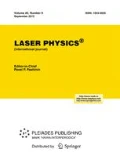Abstract
We provide a reviewlike introduction to the quantum mechanical formalism related to non-Hermitian Hamiltonian systems with real eigenvalues. Starting with the time-independent framework, we explain how to determine an appropriate domain of a non-Hermitian Hamiltonian and pay particular attention to the role played by PJ symmetry and pseudo-Hermiticity. We discuss the time evolution of such systems having in particular the question in mind of how to couple consistently an electric field to pseudo-Hermitian Hamiltonians. We illustrate the general formalism with three explicit examples: (i) the generalized Swanson Hamiltonians, which constitute non-Hermitian extensions of anharmonic oscillators, (ii) the spiked harmonic oscillator, which exhibits explicit super-symmetry, and (iii) the −x 4-potential, which serves as a toy model for the quantum field theoretical ϕ4-theory.
Similar content being viewed by others
References
H. Friedrich and D. Wintgen, Phys. Rev. A 32, 3231 (1985).
H. Geyer, D. Heiss, and M. Znojil (guest editor), Special Issue Dedicated to the Physics of Non-Hermitian Operators (PHHQP IV) (Univ. of Stellenbosch, South Africa, 2005), J. Phys. A 39, 9965 (2006).
C. Figueira de Morisson Faria and A. Fring, J. Phys. A 39, 9269 (2006).
C. M. Bender and S. Boettcher, Phys. Rev. Lett. 80, 5243 (1998).
C. M. Bender and S. A. Orszag, Advanced Mathematical Methods for Scientists and Engineers (MacGraw-Hill, New York, 1978).
A. Mostafazadeh, J. Phys. A 38, 3213–3234 (2005).
H. F. Jones and J. Mateo, Czech. J. Phys. 55, 1117 (2005).
H. F. Jones and J. Mateo, Phys. Rev. D 73, 085002(4) (2006).
J. A. C. Weideman, J. Phys. A 39, 10229 (2006).
C. M. Bender, D. C. Brody, and H. F. Jones, Phys. Rev. Lett. 89, 270401(4) (2002).
P. Dorey, C. Dunning, and R. Tateo, J. Phys. A 34, 5679 (2001).
K. C. Shin, J. Phys. A 38, 6147 (2005).
E. Wigner, J. Math. Phys. 1, 409 (1960).
S. Weigert, J. Opt. B: Quantum Semiclass. Opt. 5, S416 (2003).
S. Weigert, J. Phys. A 39, 10239 (2006).
Z. Ahmed, Phys. Lett. A 290, 19 (2001).
A. Mostafazadeh, J. Math. Phys. 43, 2814 (2002).
F. G. Scholtz, H. B. Geyer, and F. Hahne, Ann. Phys. 213, 74 (1992).
W. Heisenberg, Rev. Mod. Phys. 29, 269 (1957).
A. Mostafazadeh, J. Math. Phys. 43, 205 (2002).
A. Mostafazadeh, J. Math. Phys. 43, 3944 (2002).
A. Mostafazadeh, J. Phys. A 36, 7081 (2003).
A. Mostafazadeh, J. Math. Phys. 44, 974 (2003).
S. Weigert, Phys. Rev. A 68, 062111(4) (2003).
I. Rotter and A. F. Sadreev, Phys. Rev. E 71, 0362271(14) (2005).
E. Persson, T. Gorin, and I. Rotter, Phys. Rev. E 54, 3339 (1996).
M. Leone, A. Paoletti, and N. Robotti, Phys. Perspect. 6, 271 (2004).
H. Silverstone and C.N. Nicolaides (Ed.) (Plenum Press, New York, 1990), pp. 295.
A. Fring, V. Kostrykin, and R. Schrader, J. Phys. B 29, 5651 (1996).
C. Figueira de Morisson Faria, A. Fring, and R. Schrader, Laser Phys. 9, 379 (1999).
C. Figueira de Morisson Faria, A. Fring, and R. Schrader, J. Phys. B 33, 1675 (2000).
M. Born and V. Fock, Z. Phys. 51, 165 (1928).
A. Fleischer and N. Moiseyev, Phys. Rev. A 72, 032103(11) (2005).
M. Lewenstein, P. Salieres, A. L’Huillier, and P. Antoine, Adv. At. Mol. Opt. Phys. 41, 83 (1999).
W. Becker, F. Grasbon, R. Kopold, et al., Adv. At. Mol. Opt. Phys. 48, 35 (2002).
C. Joachain, M. Dörr, and N. Kylstra, Adv. At. Mol. Opt. Phys. 42, 225 (2000).
C. M. Bender, D. C. Brody, and H. F. Jones, Phys. Rev. D 70, 025001(19) (2004).
A. Mostafazadeh, J. Phys. A 38, 6557 (2005).
C. Figueira de Morisson Faria and A. Fring, Czech. J. Phys. 56, 899 (2006).
E. Caliceti, F. Cannata, and S. Graffi, J. Phys. A 39, 10019 (2006).
F. G. Scholtz and H. B. Geyer, Phys. Lett. B 634, 84 (2006).
F. G. Scholtz and H. B. Geyer, J. Phys. A 39, 10189 (2006).
D. B. Fairlie, J. Chaos, Solitons Fractals 10, 365 (1999).
A. Mostafazadeh, J. Math. Phys. 47, 072103(11) (2006).
C. M. Bender, D. C. Brody, J.-H. Chen, et al., Phys. Rev. D 74, 025016(10) (2006).
M. S. Swanson, J. Math. Phys. 45, 585 (2004).
H. Jones, J. Phys. A 38, 1741 (2005).
E. Witten, Nucl. Phys. B 202, 253 (1982).
F. Cooper, A. Khare, and U. Sukhatme, Phys. Rep. 251, 267 (1995).
M. Znojil, Phys. Lett. A 259, 220 (1999).
C. Figueira de Morisson Faria, A. Fring, and H. Jones (unpublished notes).
C. M. Bender, J.-H. Chen, and K. A. Milton, J. Phys. A 39, 1657 (2006).
C. M. Bender, D. C. Brody, H. F. Jones, and B. K. Meister, quanth-ph/0609032 (2006).
K. A. Milton, Czech. J. Phys. 54, 85 (2004).
C. M. Bender, I. Cavero-Pelaez, K. A. Milton, and K. V. Shajesh, Phys. Lett. B 613, 97 (2005).
C. Figueira de Morisson Faria and A. Fring (in preparation).
Author information
Authors and Affiliations
Additional information
Original Text © Astro, Ltd., 2007.
Rights and permissions
About this article
Cite this article
Faria, C.F.M., Fring, A. Non-Hermitian Hamiltonians with real eigenvalues coupled to electric fields: From the time-independent to the time-dependent quantum mechanical formulation. Laser Phys. 17, 424–437 (2007). https://doi.org/10.1134/S1054660X07040196
Received:
Issue Date:
DOI: https://doi.org/10.1134/S1054660X07040196


